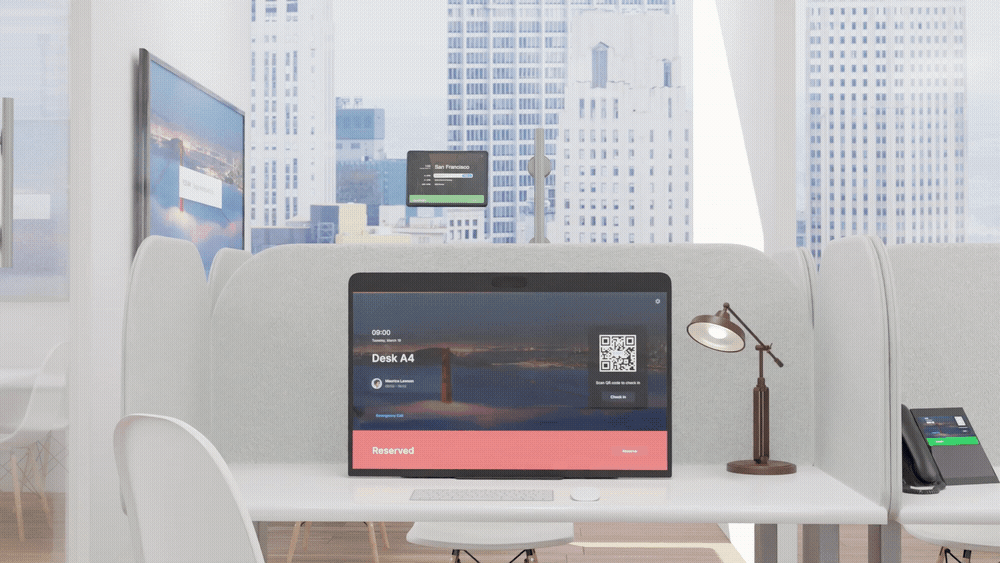
Getty Images/iStockphoto
Hybrid office design will drive tech purchasing
Tech experts predict which hybrid workplace technology from Cisco, Microsoft and Zoom companies are likely to reject or embrace. Many could favor laptops over specialized devices.
Zoom, Cisco and Microsoft believe the future of work is employees splitting their time between home and the office. So, the companies have aligned their products to serve a hybrid office where employees share desks and use video-equipped conference rooms more frequently.
Shared desks, or hot-desking, have been a common refrain from Microsoft, Cisco and Zoom. The companies have discussed using their respective collaboration platforms to reserve desks in advance and let workers sign into communication hardware using their mobile phones.
The devices could include a Teams display, a Cisco Webex Desk conference monitor, or a Zoom Rooms video conferencing system. Zoom and Microsoft plan to launch their hot-desking capabilities this year, while Cisco expects to ship its Desk product in November.
"I believe hot-desking is going to be a massive trend," Cisco executive Jeetu Patel said during his Enterprise Connect keynote.
While hot desking could become a hybrid-office staple, companies might not buy the additional hardware pitched by tech firms. Tom Arbuthnot, an IT architect at systems integrator Modality Systems, said it made more sense to provide employees with decent laptops and headsets for video conferencing than to buy specialized desk hardware.
"I think that's people with [hardware] to sell saying, 'Hey, why don't you put one of our things on each desk?'" he said.
Chris McMasters, CIO for the city of Corona, Calif., said some city offices have shared desks and are experimenting with easy sign-on. However, the city has tested using employee phones to sign into desk computers instead of buying supplemental devices.
Holly Williamson, regional design lead at architectural firm Nelson Worldwide, said some companies might install displays that let employees reserve desks and find coworkers on any given day. However, she noted that a smartphone app could accomplish the same thing for less money.
Tech firms also predict conference rooms will take on greater importance as hybrid work gains prevalence. During an Enterprise Connect panel session, Ilya Bukshteyn, general manager of Microsoft Teams devices, said he expected the number of video-equipped conference rooms to grow to five or six times what it is now.
Analysts also predict swift expansion in the use of room video. Research firm Frost & Sullivan expects the video conferencing device market to grow from $2.75 billion in 2020 to $7.71 billion by 2025. In 2018, less than 2% of the 32.4 million small meeting rooms globally had video capabilities.
Zeus Kerravala, founder of ZK Research, said companies will add video equipment to meeting rooms and replace outdated equipment.
"I do think a lot of the old equipment was in the 'good-enough' camp, where you could see people, but it was not a very good experience," he said.
Even before the pandemic, the trend in some industries, such as financial services, was toward smaller conference rooms, Williamson said.
"[Large conference rooms] weren't being used as much because the board comes in once a quarter, or maybe you present to a large client once a quarter," she said. "So much of the work was getting done in those smaller, more intimate meetings."
Having several types of conference rooms would best serve businesses, Williamson said. She noted that phone booth-style spaces could gain traction for one-on-one conversations away from the noise of the office. While Cisco, Zoom and Microsoft have touted AI-enhanced noise-canceling features for their meeting platforms, it's an open question whether they can sufficiently drown out the bustle of a workplace.
"Acoustics is going to become the next new buzzword," Williamson said. "You can't be out in the open office with everyone on a Zoom call -- it's not going to work that well."
Ultimately, the most significant trend in hybrid office design will be flexibility. Companies need to accommodate workers who want to remain socially distanced, provide spaces for collaboration and prepare for a sudden shift to whatever else is required.
"We've found over the last 18 months that there is no one-size-fits-all solution for any client anymore," Williamson said.
Mike Gleason is a reporter covering unified communications and collaboration tools. He previously covered communities in the MetroWest region of Massachusetts for the Milford Daily News, Walpole Times, Sharon Advocate and Medfield Press. He has also worked for newspapers in central Massachusetts and southwestern Vermont and served as a local editor for Patch. He can be found on Twitter at @MGleason_TT.








